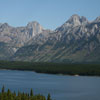Explorers
 Although the term "explorer" may provoke images of adventure and thrilling discovery, the early explorers who contributed to Alberta's place name heritage were generally employees of large-scale colonial and surveying operations, sent west for very specific purposes. Often, as in the case with explorers working for the Hudson's Bay Company, expeditions were carried out to locate new resources, establish trading with indigenous people, and facilitate territorial expansion.
Although the term "explorer" may provoke images of adventure and thrilling discovery, the early explorers who contributed to Alberta's place name heritage were generally employees of large-scale colonial and surveying operations, sent west for very specific purposes. Often, as in the case with explorers working for the Hudson's Bay Company, expeditions were carried out to locate new resources, establish trading with indigenous people, and facilitate territorial expansion.
Because of its location and climate, Alberta was one of the last regions in Canada to be visited by colonial explorers. It was not until 1754 (almost one hundred years after the establishment of the Hudson's Bay Company in North-Eastern Manitoba) that Anthony Henday, a Company fur-trader, set foot on this land. Canada's North-West was rumoured to have the best furs in all of Canada - a fact Henday was quick to confirm. Following Henday's path were a long list of explorers, fur-traders, and surveyors, excited by the promise of resources and new land. These included David Thomspon's survey and cultural study of Aboriginal tribes in 1787, James Gaddy's settlement endeavours of the same year, and Peter Fidler's fact-finding journey of 1792. Though their direct influence on Alberta place names was mostly insignificant, these pioneers paved the way for future generations of explorers by mapping uncharted regions, providing detailed accounts of the geography they encountered, as well as establishing important relations with the local Aboriginal tribes in the area.
 Arguably the most important exploration to the study of place names in Alberta was the Palliser Expedition of 1857. Lead and organized by Captain John Palliser, the son of an Irish nobleman, the expedition received support and funding from the British Imperial Commission once it realized the importance of the expedition's aims. Essentially, the journey entailed a detailed survey and charting of the Alberta plains region south of the North Saskatchewan River, all the way through the Rocky Mountains. This enormous task took the expedition (composed of Palliser and four field experts) three years to complete, but resulted in a plethora of information invaluable to the establishment of the soon-to-be Dominion of Canada in 1867. The availability of good settlement land, the discovery of a variety of passes through the treacherous Rockies, information regarding the geology and flora of the region, as well as its suitability for agriculture and other food supplies were only a few of the expedition's achievements.
Arguably the most important exploration to the study of place names in Alberta was the Palliser Expedition of 1857. Lead and organized by Captain John Palliser, the son of an Irish nobleman, the expedition received support and funding from the British Imperial Commission once it realized the importance of the expedition's aims. Essentially, the journey entailed a detailed survey and charting of the Alberta plains region south of the North Saskatchewan River, all the way through the Rocky Mountains. This enormous task took the expedition (composed of Palliser and four field experts) three years to complete, but resulted in a plethora of information invaluable to the establishment of the soon-to-be Dominion of Canada in 1867. The availability of good settlement land, the discovery of a variety of passes through the treacherous Rockies, information regarding the geology and flora of the region, as well as its suitability for agriculture and other food supplies were only a few of the expedition's achievements.
 The five men also contributed a variety of interesting names to the geographical sites they encountered. The name Kicking Horse, which applies to a river, a mountain pass, and now a popular ski destination, actually refers to an incident during the expedition, when one of Palliser's men was kicked in the chest while trying to catch a runaway horse. The Kananaskis mountain range and lake both take their names from a Native legend Palliser encountered on his travels, about a man named "kin-e-ah-kis," who received a blow from an axe and miraculously survived. The party also named a number of mountain peaks after personal friends of theirs (Moberly Flats, Mount Christie, Mount Ball), as well as one - Mount Molar - simply because it resembled a tooth!
The five men also contributed a variety of interesting names to the geographical sites they encountered. The name Kicking Horse, which applies to a river, a mountain pass, and now a popular ski destination, actually refers to an incident during the expedition, when one of Palliser's men was kicked in the chest while trying to catch a runaway horse. The Kananaskis mountain range and lake both take their names from a Native legend Palliser encountered on his travels, about a man named "kin-e-ah-kis," who received a blow from an axe and miraculously survived. The party also named a number of mountain peaks after personal friends of theirs (Moberly Flats, Mount Christie, Mount Ball), as well as one - Mount Molar - simply because it resembled a tooth!
Palliser also leant his name to a large tract of semi-arid land which stretched across parts of Manitoba, Saskatchewan, southern Alberta, and down into the northern States. "Palliser's Triangle," as the area is now called, was designated unsuitable for farming, and Palliser's reports on the region had a large impact on settlement patterns of the time.
These and other 18th and 19th Century explorers had an important role in bestowing the place names of Alberta that are so familiar to us today. Their origins reveal stories and details which give us a greater understanding of our own cultural heritage.



